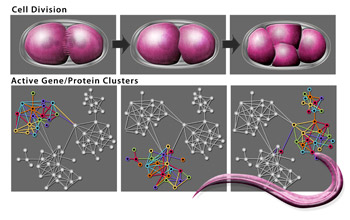Multimedia Gallery
Worm Studies on Embryo Formation
Networks of functionally linked genes and proteins (shown as interconnected nodes in bottom panel) coordinate early embryo development in the roundworm C. elegans (bottom right). The top panel depicts the first two cell divisions of the C. elegans embryo. Individual groups or clusters of molecules that work together--dubbed "molecular machines" by the researchers--operate at specific times in development. Colored nodes in the bottom panel show an artist's conception of active regions in the network during these early stages.
How does a multi-cellular organism with specialized organs and tissues develop from a single cell? A team of genomics researchers has moved closer to answering this question by creating the first comprehensive diagram of the molecular interactions that orchestrate early embryo development. The National Science Foundation (NSF) supported two members of the research team, one of which received an NSF ADVANCE (Increasing the Participation and Advancement of Women in Academic Science and Engineering Careers) fellows award--a program to increase representation and advancement of women in academic science and engineering careers.
This image accompanied NSF press release, "Worm Studies Give Researchers New Perspective on Embryo Formation."
Credit: Nicolle Rager Fuller, National Science Foundation
Images and other media in the National Science Foundation Multimedia Gallery are available for use in print and electronic material by NSF employees, members of the media, university staff, teachers and the general public. All media in the gallery are intended for personal, educational and nonprofit/non-commercial use only.
Images credited to the National Science Foundation, a federal agency, are in the public domain. The images were created by employees of the United States Government as part of their official duties or prepared by contractors as "works for hire" for NSF. You may freely use NSF-credited images and, at your discretion, credit NSF with a "Courtesy: National Science Foundation" notation.
Additional information about general usage can be found in Conditions.
Also Available:
Download the high-resolution JPG version of the image. (1.6 MB)
Use your mouse to right-click (Mac users may need to Ctrl-click) the link above and choose the option that will save the file or target to your computer.

